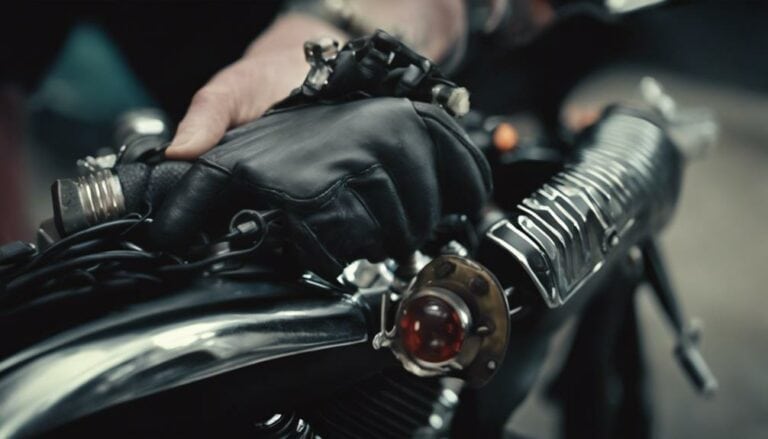When it comes to removing the rear fender harness plug on your Harley Davidson, it may seem like a challenging task at first, but fear not, it can be done with the right guidance.
The process involves a few intricate steps that require precision and attention to detail. By following the outlined steps and taking necessary precautions, you can successfully navigate through this task and make sure your Harley is in top condition.
So, let's get started on unraveling the mysteries behind this essential maintenance procedure!
Key Takeaways
- Locate and identify the rear fender harness plug under the seat for Harley Davidson.
- Disconnect the plug carefully, noting wire colors and positions to ensure proper removal.
- Remove the rear fender by releasing mounting bolts and guiding the wiring harness out.
- Reassemble securely, conduct functional tests, and lock the plug in place for rear lighting system integrity.
Preparing the Necessary Tools
To prepare for removing the rear fender harness plug on your Harley Davidson, gather essential tools such as a screwdriver, pliers, and potentially a rivet gun depending on your model. These tools are vital for a successful removal process without causing any damage to the wiring harness or components. The screwdriver will aid in loosening screws or fasteners holding the harness in place, while pliers can help disconnect any connectors securely. In some cases, certain Harley Davidson models may have rivets securing the harness plug, requiring a rivet gun for removal.
Having the right tools ready before starting the removal process is key to ensuring a smooth and efficient operation. By utilizing these tools correctly, you can disconnect the rear fender harness plug with ease, empowering you to work on your Harley Davidson without unnecessary hindrances.
Locating the Rear Fender Harness Plug
If you've prepared your tools, the next step is to locate the rear fender harness plug on your Harley Davidson motorcycle, typically situated under the seat. This important connector houses the wires responsible for rear lighting functions, aiding in safe riding.
The rear fender harness plug is usually a multi-lock, 6-way connector with wires colored Orange/White, Brown, Blue, Red/Yellow, Violet, and Black. Identifying this plug accurately is essential for successful removal of the rear fender.
To locate it precisely, consult the specific Harley-Davidson wiring diagram for your model, ensuring you understand the wiring setup. Knowing the color codes and wire placements will assist you in recognizing the harness plug.
Take your time to familiarize yourself with the plug's location and the wires connected to it. This preparation will make the next steps of disconnecting and removing the harness plug much smoother and more efficient.
Disconnecting the Harness Plug
When disconnecting the harness plug on your Harley Davidson, make sure that you have identified the specific number of pins or connectors present. This step is important as different models may have varying configurations. To successfully disconnect the harness plug, follow these steps:
- Locate the Harness Plug: Under the seat of your Harley Davidson, find the harness plug that connects the rear lighting functions. It's typically secured within the fender area.
- Gently Disconnect the Plug: Carefully separate the harness plug by firmly grasping the connector and gently pulling it apart. Avoid using excessive force to prevent any damage to the wires or connectors.
- Document Wire Positions: Before fully disconnecting the plug, take note of the wire colors and their positions. This documentation will assist you during reassembly to make sure the correct connections are made.
Removing the Rear Fender
Locate the 6-way connector under the seat of your Harley Davidson to prepare for the removal of the rear fender.
To begin, consult the wiring diagram (99949-07_en_v1.1) for specific guidance on disconnecting the rear fender harness plug.
Next, remove any mounting bolts or screws securing the rear fender to the frame using the appropriate tools.
Carefully lift the fender away from the tire, ensuring no wires are being stretched or strained.
Once the fender is free, gently guide the wiring harness out of the conduit, which is typically slightly off-center under the fender.
Take note of how the wiring is routed for reinstallation. Prioritize the integrity of the wiring harness as you proceed.
If you encounter any challenges during this process, consider seeking assistance from a motorcycle forum or online discussion to troubleshoot effectively.
With the rear fender removed and the wiring disconnected, you're one step closer to your desired modifications.
Final Checks and Reassembly
Begin by carefully inspecting the rear fender harness plug to guarantee all wires are securely and correctly seated.
- Verify Wire Colors and Connections: Double-check that the wire colors and connections match the wiring diagram to ensure accurate reassembly.
- Listen for Confirmation: When reinserting the plug, listen for a distinct click sound, indicating a secure and proper connection.
- Functional Test: After reassembly, conduct a thorough functional test of the rear lighting system to ensure it operates correctly.
These steps are important to guarantee a successful reassembly of the rear fender harness plug on your Harley-Davidson motorcycle.
Once you have completed these checks and reconnected the plug securely, lock it in place to prevent any accidental disconnections while riding.
Conclusion
To sum up, removing the rear fender harness plug on a Harley Davidson motorcycle is a straightforward process that requires attention to detail and the right tools.
Remember to double-check all connections and take your time to make sure everything is securely reattached.
As the saying goes, 'measure twice, cut once.'
Following these steps will help maintain your bike's functionality and keep you safe on the road.

